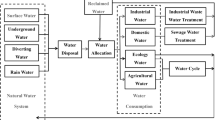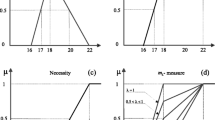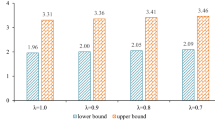Abstract
To sustain water quality in water distribution system (WDS), disinfectant generally chlorine is boosted to water distribution system. However, the concentration of chlorine should be limited to acceptable scope. The upper bound of the scope is set for preventing the occurrence of disinfectant byproduct, which is harmful to human health. The lower bound of the scope is set for controlling the growth of microorganism as well as reducing the cost. As such, the optimization model was applied to solve the water quality issue in WDS. However, in WDS, chlorine decays and varies with time and space, affected by pipe material, temperature, pH value, and chlorine injection. Therefore, in this paper, an inexact \({\mathrm{m}}_{\uplambda }\) fuzzy chance-constrained programming (IMFCCP) model was proposed to optimize the chlorine injection to maintain chlorine in WDS at an acceptable level with consideration of uncertainty in water quality simulation. The results indicated that the upper bounds, the lower bounds, and intervals of the injection mass increased with preference parameter λ, which means that the results are more unreliable with higher preference parameter λ. However, the effect of reliability level ζ on the injection mass is determined by the relationship between the preference parameter λ and reliability level ζ. In case of \(\uplambda \le {\upzeta }_{\mathrm{U}}={\upzeta }_{\mathrm{L}}\), the effect is not more significant than the case of \(\uplambda >{\upzeta }_{\mathrm{U}}={\upzeta }_{\mathrm{L}}\). The results can help managers determine the injection strategy under uncertainty.






Similar content being viewed by others
References
Archibald, T. W., & Marshall, S. E. (2018). Review of mathematical programming applications in water resource management under uncertainty. Environmental Modeling & Assessment, 23(6), 753–777.
Babayan A., Kapelan Z., Savic D., & Walters G. (2005). Least-cost design of water distribution networks under demand uncertainty. Journal of Water Resources Planning and Management, 131(5), 375–382.
Boccelli, D. L., Tryby, M. E., Uber, J. G., Rossman, L. A., Zierolf, M. L., & Polycarpou, M. M. (1998). Optimal scheduling of booster disinfection in water distribution systems. Journal of Water Resources Planning and Management, 124(2), 99–111.
Dai, C., Cai, Y. P., Li, Y. P., Sun, W., Wang, X. W., & Guo, H. C. (2014). Optimal strategies for carbon capture, utilization and storage based on an inexact mλ-measure fuzzy chance-constrained programming. Energy, 78, 465–478.
Dai, C., Cai, Y. P., Liu, Y., Wang, W. J., & Guo, H. C. (2015). A Generalized interval fuzzy chance-constrained programming method for domestic wastewater management under uncertainty—A case study of Kunming, China. Water Resources Management, 29(9), 3015–3036.
Goyal, R. V., & Patel, H. M. (2014). Analysis of residual chlorine in simple drinking water distribution system with intermittent water supply. Applied Water Science, 5(3), 311–319.
Haghighi, A., & Asl, A. Z. (2014). Uncertainty analysis of water supply networks using the fuzzy set theory and NSGA-II. Engineering Applications of Artificial Intelligence, 32, 270–282.
Huang, X. (2006). Credibility-based chance-constrained integer programming models for capital budgeting with fuzzy parameters. Information Sciences, 176(18), 2698–2712.
Köker, E., & Altan-Sakarya, A. B. (2015). Chance constrained optimization of booster chlorination in water distribution networks. CLEAN - Soil, Air, Water, 43(5), 717–723.
Lansey, K., Pasha, F., Pool, S., Elshorbagy, W., & Uber, J. (2007). Locating satellite booster disinfectant stations. Journal of Water Resources Planning and Management, 133(4), 372–376.
Lansey, K. E., Duan, N., Mays, L. W., & Tung, Y.-K. (1989). Water distribution system design under uncertainties. Journal of Water Resources Planning and Management, 115(5), 630–645.
Li, X. M., Lu, H. W., Li, J., Du, P., Xu, M., & He, L. (2015). A modified fuzzy credibility constrained programming approach for agricultural water resources management—A case study in Urumqi, China. Agricultural Water Management, 156, 79–89.
Li, Z., Huang, G., Zhang, Y., & Li, Y. (2013). Inexact two-stage stochastic credibility constrained programming for water quality management. Resources, Conservation and Recycling, 73, 122–132.
Liu, B., & Iwamura, K. (1998). Chance constrained programming with fuzzy parameters. Fuzzy Sets and Systems, 94, 227–237.
Liu, B., & Liu, Y. K. (2002). Expected value of fuzzy variable and fuzzy expected value models. IEEE Transactions on Fuzzy Systems, 10(4), 445–450.
Maqsood, I., Huang, G. H., & Scott Yeomans, J. (2005). An interval-parameter fuzzy two-stage stochastic program for water resources management under uncertainty. European Journal of Operational Research, 167(1), 208–225.
Marques, J., Cunha, M., & Savić, D. A. (2015). Multi-objective optimization of water distribution systems based on a real options approach. Environmental Modelling & Software, 63, 1–13.
Nouiri, I. (2017). Optimal design and management of chlorination in drinking water networks: A multi-objective approach using genetic algorithms and the Pareto optimality concept. Applied Water Science, 7(7), 3527–3538.
Rossman, L. A., Clark, R. M. & Grayman, W. M. (1994). Modeling chlorine residuals in drinking-water distribution systems. Journal of Environmental Engineering, 120, 803–820.
Ruiz-Vanoye, J., Barrera-Cámara, R., Díaz-Parra, O., Fuentes-Penna, A., Pérez Ortega, J., Bernabe Loranca, B., Canepa Saenz, A., & Santiago-Pérez, J. D. C. (2018). Surveying the optimization problems of water distribution networks. Polish Journal of Environmental Studies, 27(4), 1425–1432.
Singh, A. & Minsker, B. S. (2008). Uncertainty-based multiobjective optimization of groundwater remediation design. Water Resources Research, 44(2).
Singh, A. P., Dhadse, K., & Ahalawat, J. (2019). Managing water quality of a river using an integrated geographically weighted regression technique with fuzzy decision-making model. Environmental Monitoring and Assessment, 191(6), 378.
Singh, A. P., Ghosh, S. K., & Sharma, P. (2007). Water quality management of a stretch of river Yamuna: An interactive fuzzy multi-objective approach. Water Resources Management, 21(2), 515–532.
Xin, K., Zhou, X., Qian, H., Yan, H., & Tao, T. (2019). Chlorine-age based booster chlorination optimization inwater distribution network considering the uncertainty of residuals. Water Science & Technology: Water Supply, 19(3), 796–807.
Xu, T. Y., & Qin, X. S. (2014). Integrating decision analysis with fuzzy programming: Application in urban water distribution system operation. Journal of Water Resources Planning and Management, 140(5), 638–648.
Zadeh, L. A. (1999). Fuzzy sets as a basis for a theory of possibility. Fuzzy Sets and Systems, 100, 9–34.
Zhang, C., Engel, B. A., & Guo, P. (2018). An interval-based fuzzy chance-constrained irrigation water allocation model with double-sided fuzziness. Agricultural Water Management, 210, 22–31.
Zhang, C., & Guo, P. (2017). A generalized fuzzy credibility-constrained linear fractional programming approach for optimal irrigation water allocation under uncertainty. Journal of Hydrology, 553, 735–749.
Zhang, C., Zhang, F., Guo, S., Liu, X., & Guo, P. (2018). Inexact nonlinear improved fuzzy chance-constrained programming model for irrigation water management under uncertainty. Journal of Hydrology, 556, 397–408.
Acknowledgements
We also acknowledge US Environmental Protection Agency for supplying EPANET software freely downloaded on website.
Funding
This work was also funded by the Water Pollution Control Project in Taihu (Grant No. TH2018403). This work was funded by Jiangsu Overseas Visiting Scholar Program for University Prominent Young and Middle-aged Teachers and Presidents (2017).
Author information
Authors and Affiliations
Corresponding author
Additional information
Publisher's Note
Springer Nature remains neutral with regard to jurisdictional claims in published maps and institutional affiliations.
Rights and permissions
About this article
Cite this article
Wang, Y. Inexact \({\mathrm{m}}_{\uplambda }\) fuzzy chance-constrained programming of booster chlorination for water distribution system under uncertainty. Environ Monit Assess 193, 300 (2021). https://doi.org/10.1007/s10661-021-09047-5
Received:
Accepted:
Published:
DOI: https://doi.org/10.1007/s10661-021-09047-5




